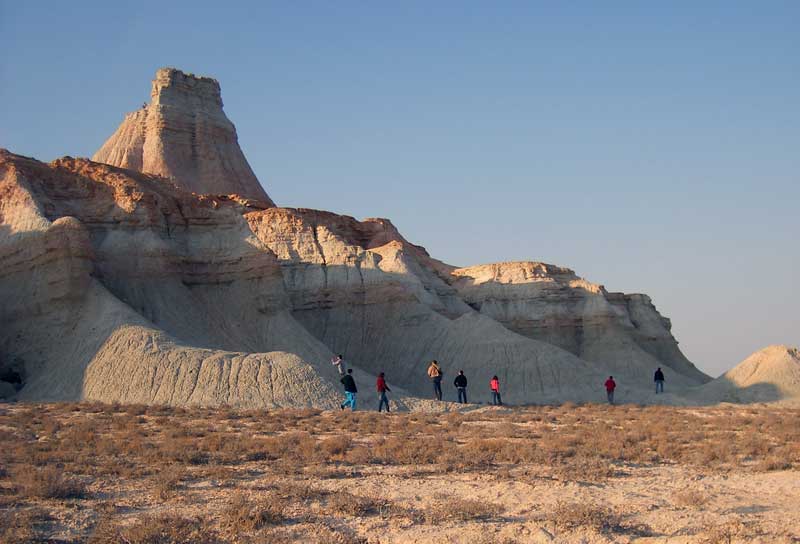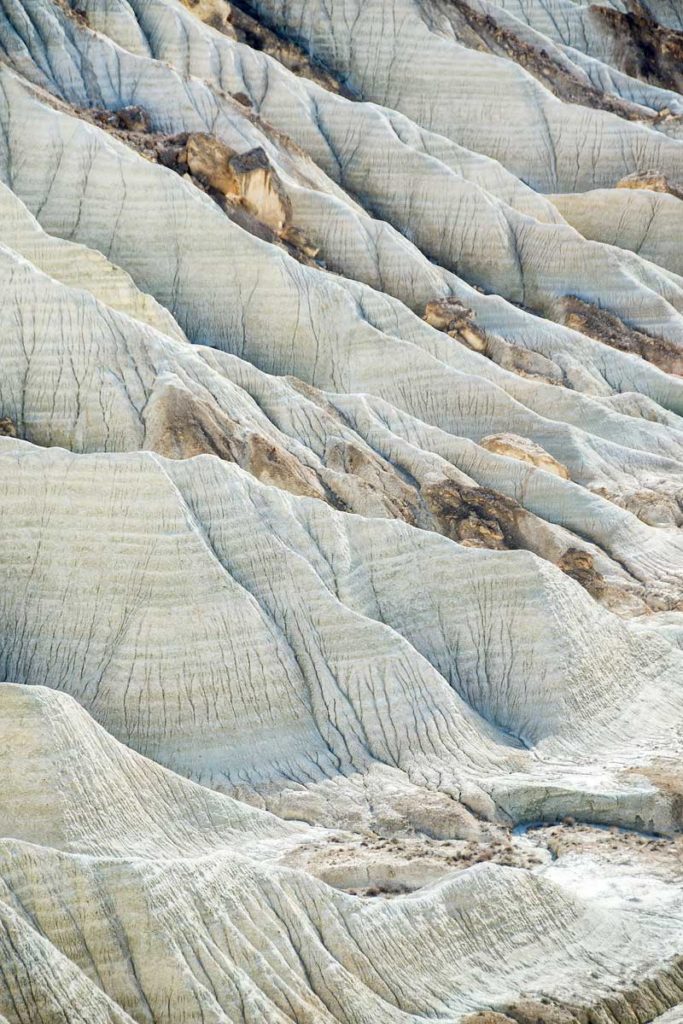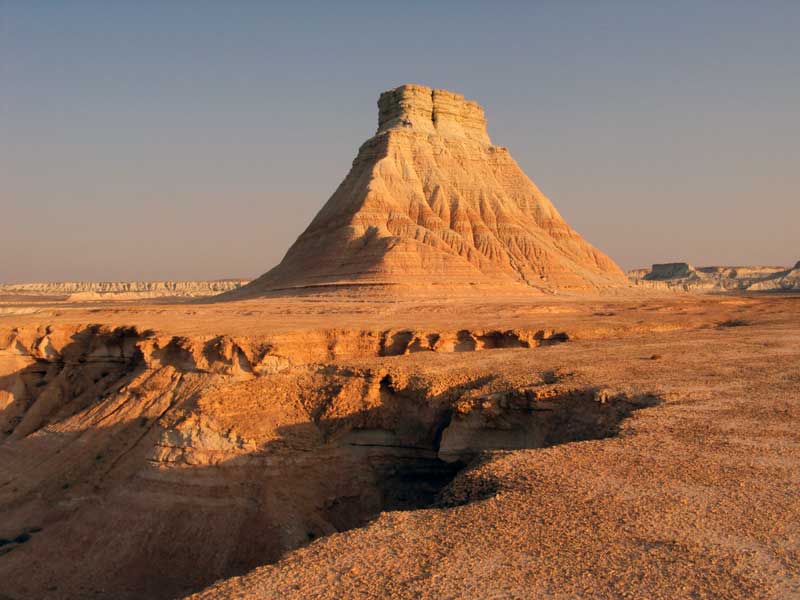The most mysterious and under-explored of Central Asia’s five ‘stans, Turkmenistan is an unparalleled travel destination like no other. Those who visit this little-known nation tend to focus their attentions on Ashgabat — Turkmenistan’s glittering modern capital with gleaming gold and white marble monuments — with little time dedicated to anything else. But travelers who look beyond the showcase city will discover that Turkmenistan is rich in captivating curiosities just waiting for further exploration.
Turkmenistan’s remote deserts are filled with rare experiences, such as meeting semi-nomadic villagers
Even the most remote corners of the country mesmerize with sights both unique and unusual, from ancient Silk Road cities slowly crumbling away into the desert, to oddities like the flaming “Door to Hell” gas crater, Darvaza. Few tourists visit these remarkable places, giving those who make the journey the sense of feeling like a true travel pioneer. Here’s our guide for how and where to get in touch with the real, remote Turkmenistan.
The Turkish government assisted in restoring the 12th-century Sultan Sanjar Mausoleum, one of the finest remaining structures of the once-mighty Seljuk Empire
1. Marvel at the Mysteries of Merv
Formed along the mouth of the Murghab River where it soaks into the Kara Kum Desert, the fertile oasis of Merv has supported human life for over 4,000 years. Several cities existed here throughout history, the earliest of which is attributed to Cyrus the Great in the 6th century BC. Throughout its evolution, Merv was a major center of Islam, a busy hub on the Silk Road, and a city absolutely integral to Central Asia’s development.
Originally built by the Sassanians in the 7th century, the Great Kyz Kala was used as residences for the aristocracy
Photo credit: Douglas Grimes
The ruins of Merv were listed as a UNESCO World Heritage Site in 1999 because of the wealth of ongoing information they offer regarding the evolution of urban centers. Among the most important sights travelers can explore are the 38-meter-tall mausoleum of Sultan Sanjar, built in the 12th century, and the massive ribbed Kyz Kala, or “Maiden’s Fortress.”
Peering into the depths of Darvaza Gas Crater, one of Turkmenistan’s most unusual sights
Photo credit: Justin & Crystal Barnes
2. Camp on THE Edge of Turkmenistan’s “Door to Hell”
At the heart of the Kara Kum Desert is the Darvaza Gas Crater, one of Turkmenistan’s most unusual sights, located some 160 miles north of Ashgabat. Nicknamed the “Door to Hell,” Darvaza was a site of Soviet natural gas exploration in the 1970s. The story goes that while workers were drilling into an underground cavern, the ground collapsed and created a large sinkhole, swallowing the drilling rig and releasing deadly methane gas. Engineers decided to burn off the gas to make the cavern safe for more drilling. More than 40 years later, Darvaza’s fire is still burning strong.
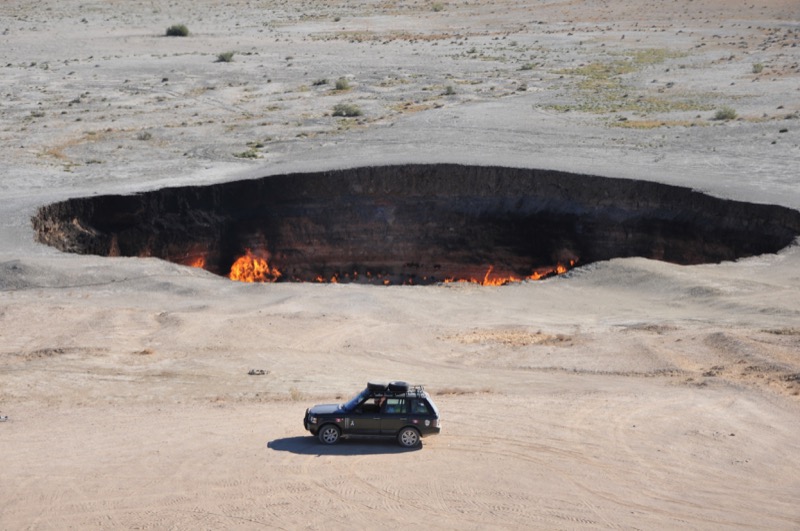
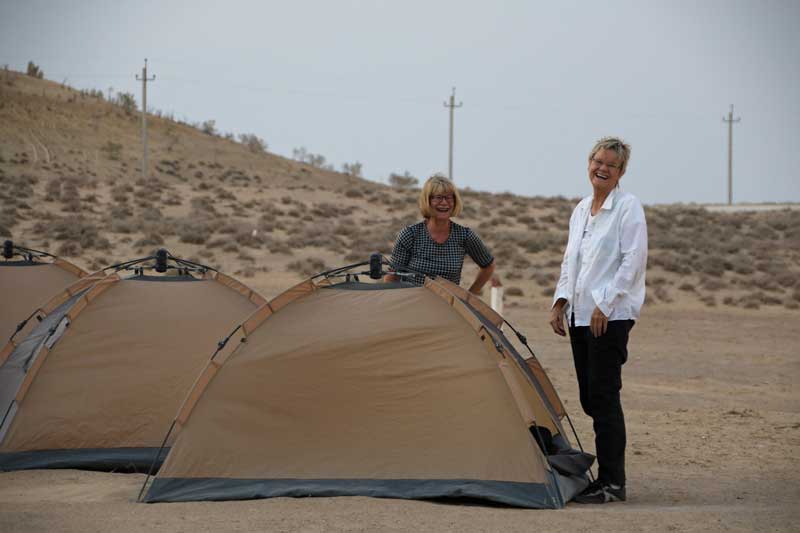
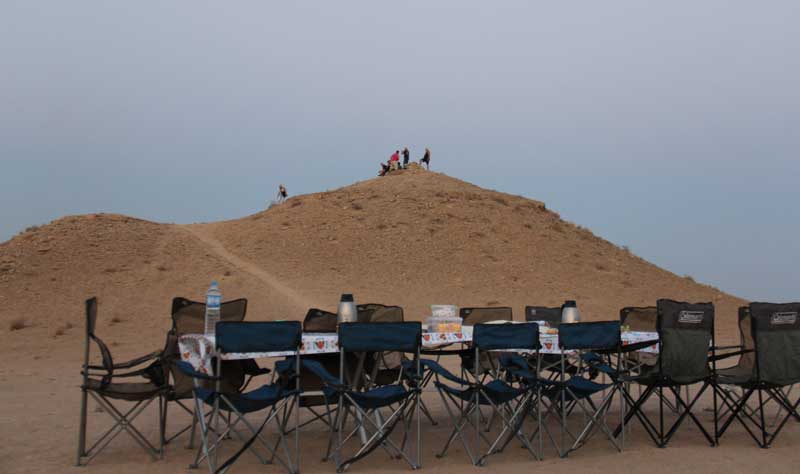
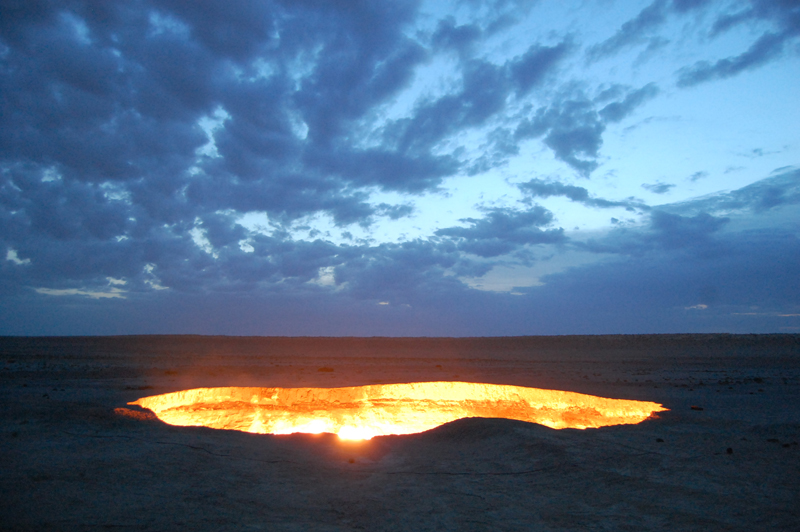
Even in daytime, Darvaza Gas Crater is a jarring sight in the desert
Photo credit: Donovan Wong
Although quite stunning even in bright sun, Darvaza is best seen at night, when the crater’s eerie glow is visible from miles away. The experience is even more amplified if you camp overnight in tents pitched near the crater’s edge. You can easily get lost staring at Darvaza’s flickering flames, just like when you’re sitting around a campfire. Enjoy an al fresco barbecue-style dinner at the camp before venturing out to snap stunning pictures of the crater under the night sky.
The 12th-century Turabek Khanym Mausoleum is one of the best preserved buildings in old Kunya-Urgench
Photo credit: Abdu Samadov
3. Step Back in Time at Kunya-Urgench
Deep in the remote northern deserts near the Uzbek border is Kunya-Urgench, the capital of the once mighty Khorezmian Empire. Prominently positioned along the Amu Darya River, Kunya-Urgench became one of Central Asia’s most important trading cities and a major center of learning and culture in the Muslim world. Genghis Khan and Tamerlane successively razed the city in the 13th and 14th centuries; although later rebuilt, Kunya-Urgench never returned to its former glory.
(click on photo for larger image and caption)
Today, Kunya-Urgench is an everyday agricultural center, but evidence of its extraordinary past is still visible in the remains of the old city, located about half a mile south of town. The UNESCO-listed complex includes the 1,000-year-old Kutlug-Timur Minaret, ringed with 18 bands of decorative mud brick and blue majolica tiles. For many years it was the tallest minaret in Central Asia.
Mesmerizing geometric patterns of Turabek Khanym’s inner dome represent the heavens, radiating from 12 star-like medallions
Photo credit: Donovan Wong
Also admire the domed hall of the Turabek Khanym Mausoleum, with its remarkably preserved interlocking ceiling design. The mausoleum was built for the daughter of one of the leaders of the Golden Horde.
Villagers in remote Nohur, where their tribal culture and traditions remain intact
4. Visit a Traditional Tribal Village in Nohur
3,600 feet above the Kara Kum Desert lie the cool valleys and hillside villages of the Nohur people. The tribal Nohuri have long been isolated from the rest of the country, and to a great extent have held on to their culture and traditions. Families grow tomatoes, pomegranates, and almonds that are prized in the markets of Ashgabat. But it’s Nohuri women who are particularly renowned for their silk embroidery and the special pre-Islamic patterns of their felt.
A local Nohuri weaver demonstrates how she fashions silk textiles in the traditional way, handed down from generation to generation
You can get a better understanding of Nohuri culture and customs by visiting their small mountain villages nestled in the Sumbar River Valley. The tiny alleyways of the villages are lined with houses made of stacked stone, ornamented with carved timbers found nowhere else in Turkmenistan. In one of the villages is an old yurt workshop, with a kiln used to steam the wooden ribs of Nohuri yurts.
Gravestones in Nohur are often decorated with sheep horns, a traditional symbol of prosperity
You’ll notice that Nohuri gravestones are decorated with the horns of Urial mountain sheep, an animal associated with prosperity and fertility. Not far away is a sacred cave where village women go to pray to Kiz-bibi, the goddess of fertility, for harmony in their families, or to conceive a child. Women often tie colorful cloths and little cradles to the branches of a nearby “wishing tree” in the hopes that the goddess will answer their prayers.
The difference that millions of years can make: Yangykala Canyon was once the bottom of an ancient seabed
5. Admire the Alluring Colors of Yangykala Canyon
Hidden in the desert plains east of the Caspian Sea is gorgeous Yangykala Canyon, one of the most remote and spectacular natural sights in Turkmenistan. An ancient seabed that dried out millions of years ago, the canyon was gradually formed as the receding waters eroded away at the landscape, creating a staggering number of deep-cut gorges and steep, folded cliffs.
Yangykala means “fire fortress” in Persian — a perfectly poetic name for the canyon’s brilliant bands of red, white, and pink rock that seem to set alight at sunrise and sunset. Many visitors like to spend a few hours hiking through the beautiful desert landscape to admire its panoramic views. But you can also choose to camp on the plateau above the canyon, where you’ll have a truly unique vantage point from which to admire this breathtaking natural wonder.
The ancient site of Gonur-Depe (“Gray Hill”) was recently discovered, buried in the Karakum Desert sands
Photo credit: Michel Behar
6. Discover the Ancient Ruins of Gonur-Depe
Only recently uncovered by Soviet archaeologists in the mid-20th century, the fortress town of Gonur-Depe was once a thriving urban center of the mysterious Bronze Age Oxus Civilization. Dating back to around 2500 BC, the site was surrounded by strong fortress walls with adobe homes and buildings; their remnants can still be seen in this rural corner of Turkmenistan some 45 miles north of Merv.
Gonur-Depe continues to undergo excavation, but visitors can still walk around and explore some of the city’s most fascinating discoveries, including a palace, Zoroastrian fire temple, and necropolis. Scholars believe that Gonur-Depe may have been the birthplace of Zoroastrianism, the world’s first religion to promote monotheism and the belief in a final Judgment Day and resurrection.
Gonur-Depe shares many similarities with civilizations in Mesopotamia and the Indus Valley
Photo credit: Michel Behar
The excavations at Gonur-Depe have produced a multitude of artifacts, ranging from figurines and pottery to advanced infrastructure and a drainage system that indicates a highly complex society for that time. Archaeologists have also uncovered thousands of human and animal graves, including a royal tomb illustrating the ancient Zoroastrians’ unique burial practices.
Mountains and valleys of the Koytendag Nature Reserve, located at the easternmost edge of Turkmenistan
7. Follow in THE Footsteps of Dinosaurs at Koytendag Nature Reserve
One of Turkmenistan’s most pristine natural areas is the beautiful Koytendag Nature Reserve, which translates as “mountains of deep canyons.” Located on the western slope of the Kugitang Mountain Range, the reserve was founded in 1986 to help preserve the habitat of the endangered markhor, or wild mountain goat. The reserve is a nominee as a UNESCO World Heritage Site. Koytendag encompasses the country’s highest peak, 10,295-feet Mount Airybaba, along with several enormous gorges, karst caves filled with glittering stalactites and stalagmites, and forests of walnut and maple.
A human shoe is dwarfed by a dinosaur’s footprint on the Dinosaur Plateau
Perhaps its most famous attraction, however, is Dinosaur Plateau, where more than 400 fossilized dinosaur footprints were discovered – the largest repository of its kind in the world. Created over 40 million years ago, the prints were perfectly preserved by a layer of volcanic lava until decades of geologic activity and erosion gradually exposed them. You can freely explore the hundreds of footprints and imagine what it must have been like to walk among the dinosaurs.
Turkmen women typically wear long, patterned dresses with hair pulled back around an elongated metal dome, then covered with a brightly colored scarf
Photo credit: Bill Thornton
MORE CENTRAL ASIAN INSPIRATIONS: STORIES, PHOTOS & VIDEOS
Here are more ways to discover why now is a perfect time to travel to Turkmenistan, as well as to its Central Asian sister ‘stans – Kazakhstan, Kyrgyzstan, Tajikistan, and Uzbekistan:
Up & Coming Uzbekistan: 7 Reasons Why A Local Recommends You Visit Now
Sounds of the Silk Route: Music of the Karakalpaks (video)
(Top feature photo – Living life on the edge at Darvaza Gas Crater. Photo credit: Jeremy Woodhouse
Additional photos courtesy Owadon Tourism)
















